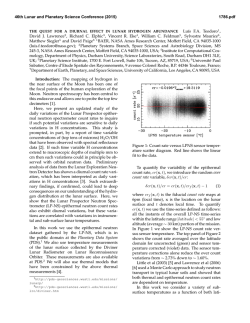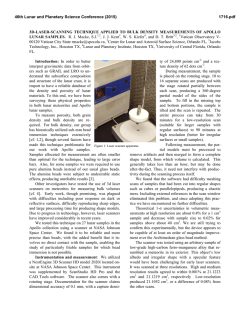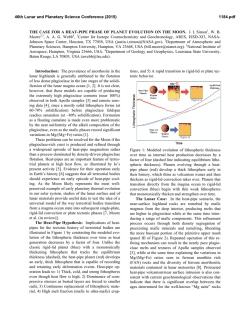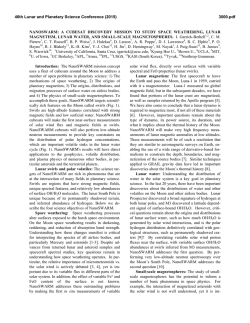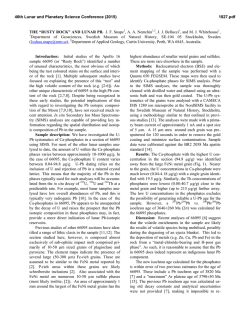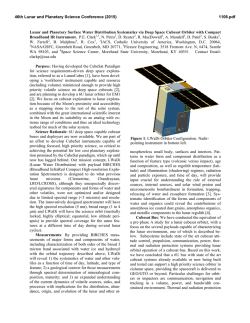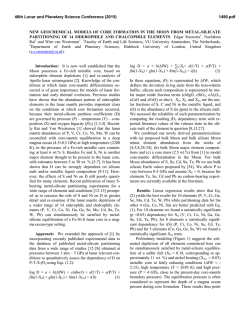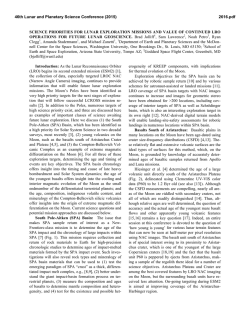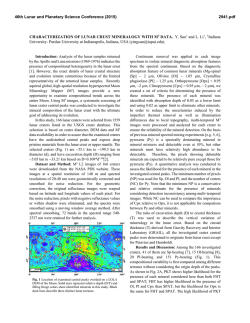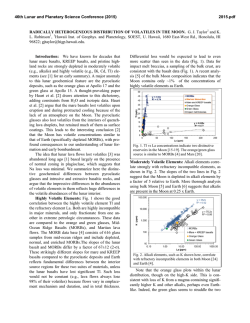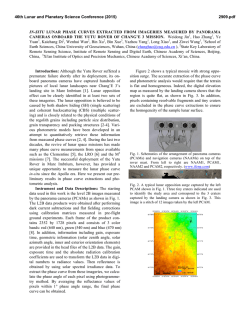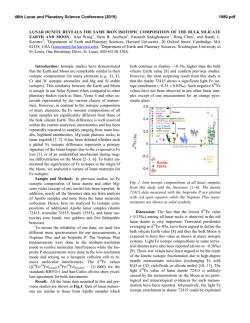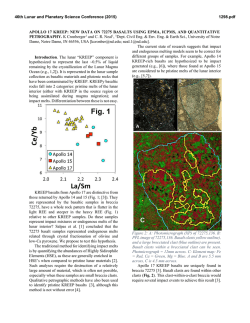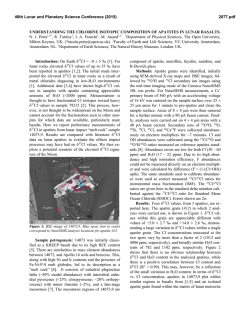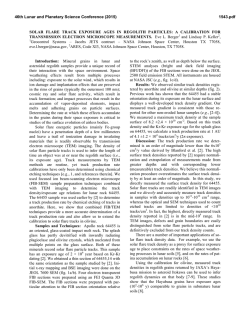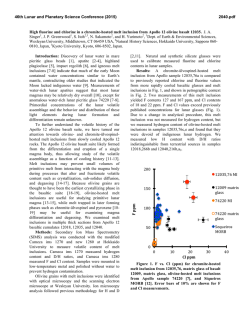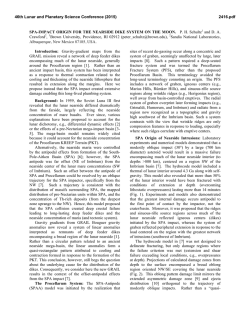
comprehensive non-destructive conservation - USRA
46th Lunar and Planetary Science Conference (2015) 2740.pdf COMPREHENSIVE NON-DESTRUCTIVE CONSERVATION DOCUMENTATION OF LUNAR SAMPLES USING HIGH-RESOLUTION IMAGE-BASED 3D RECONSTRUCTIONS AND X-RAY CT DATA. E. H. Blumenfeld1, C. A. Evans2, E. R. Oshel3, D. A. Liddle3, K. Beaulieu3, R. A. Zeigler2, and R. D. Hanna4, R. A. Ketcham4, 1Transdiscplinary Artist and Researcher ([email protected]), 2NASA Johnson Space Center, Houston TX 77058 ([email protected]), 3 JETS, NASA JSC, Houston TX 77058, 4UTCT Facility, Jackson School of Geosciences, University of Texas at Austin, Austin TX, 78712. Introduction: Established contemporary conservation methods within the fields of Natural and Cultural Heritage encourage an interdisciplinary approach to preservation of heritage material (both tangible and intangible) that holds “Outstanding Universal Value” for our global community [1]. NASA’s lunar samples were acquired from the moon for the primary purpose of intensive scientific investigation. These samples, however, also have cultural significance, as evidenced by the millions of people per year that visit lunar displays in museums and heritage centers around the world [2]. Being both scientifically and culturally significant, the lunar samples require a unique conservation approach. Government mandate dictates that NASA’s Astromaterials Acquisition and Curation Office develop and maintain protocols for “documentation, preservation, preparation and distribution of samples for research, education and public outreach” for both current and future collections of astromaterials [3]. Documentation, considered the first stage within the conservation methodology, has evolved many new techniques since curation protocols for the lunar samples were first implemented, and the development of new documentation strategies for current and future astromaterials is beneficial to keeping curation protocols up to date. We have developed and tested a comprehensive non-destructive documentation technique using high-resolution image-based 3D reconstruction and X-ray CT (XCT) data in order to create interactive 3D models of lunar samples that would ultimately be served to both researchers and the public [4]. These data enhance preliminary scientific investigations including targeted sample requests, and also provide a new visual platform for the public to experience and interact with the lunar samples. We intend to serve these data as they are acquired on NASA’s Astromaterials Acquisistion and Curation website at http://curator.jsc.nasa.gov/. Providing 3D interior and exterior documentation of astromaterial samples addresses the increasing demands for accessability to data and contemporary techniques for documentation, which can be realized for both current collections as well as future sample return missions. Objective: Our aim was to enhance our preservation efforts through non-destructive imaging of a lunar sample. Using two novel methods, we would produce linked 3D reconstructions of the sample, depicting both its visual and compositional interior and exterior characteristics. This would be achieved by combining high-resolution precision photography with Structure From Motion (SFM) photogrammetry and XCT scanning. These data result in a comprehensive 3D representation of both the exterior surface and internal compositional and textural details of the sample. The ultimate objective would be to align and combine the images and XCT data in order to render a single reconstruction containing both visual and compositional information. These combined 3D constructions would then be presented through a web-based end-user data console, such that all interior and exterior characteristics of the sample would be accessible simultaneously and would provide the viewer with the means to move freely through the sample and locate areas of interest by a coordinate system. Preliminary design of the Astromaterials Research Console (ARC) Viewer Station, showing here Lunar Sample 6063., Included are a window for the SFM 3D model, a window of the 3D XCT model, and the X, Y, Z axis cross-sections of the XCT data detailing the internal composition and texture of the sample. Method: A multidisciplinary team with expertise in the fields of conservation practices, professional photography, photogrammetry, imaging science, geoscience and astromaterials curation collaborated to investigate non-destruction documentation methods for the preservation of NASA’s astromaterials, performing intital tests on lunar and meteoritic samples. Having designed and fabricated a calibrated rotation stage in order to facilitate incremental sequencing of the sample’s surface during the image-taking pro- 46th Lunar and Planetary Science Conference (2015) cess, we worked with calibrated professional photographic hardware to produce high-resolution digital photographs of our test sample, Apollo Sample 60639. The Lunar Laboratory is a multi-clean room facility, where samples are stored in positively pressurized nitrogen-only environments with dedicated housing for each Apollo mission so there is no cross-contamination between mission samples [3]. The pristine lunar samples are permitted to come into contact with limited terrestrial materials, including Grade C nitrogen, 304 stainless steel, series 6100 aluminum alloy, and Teflon. As such, compliance with curation and conservation protocols meant it was necessary to photograph the lunar sample inside its designated nitrogen cabinet within the Lunar Lab. Thus, all photography of the moon rock occured from outside the cabinet looking through the Scientific Observation (SO) Port, which is constructed of optical glass. Lens distortion was calculated for this material in order to compensate for it. 2740.pdf [5]. These data provide researchers an information-rich visualization of compositional and textural information prior to any physical sampling, and additional avenues for research through 3D image analysis. The fusion of the data sets presents many challenges, and further methods are in development to coregister the two data sets and provide web-based tools to explore these samples interactively. Anaglyph Structure-From-Motion (SFM) 3D reconstruction of Apollo Lunar Sample 60639 produced from the high-resolution precision images (3D glasses required). High-resolution precision photography set up in Lunar Lab with Apollo Lunar Sample 60639 on rotation stage. Photographs were taken in 15-degree increments, at several elevations, totaling approximately 240 images. Images were then processed and imported into an offthe-shelf Structure-From-Motion (SMF) 3D reconstruction software where, using photogrammetric principles, an accurate image-based 3D model of Apollo sample 60639 was created. Our post-rendering calculations of this 3D model demonstrated an image resolution equal to 60 microns, and we have determined that with further refinement to our data collection procedure we can attain twice this resolution. X-ray computed tomography (XCT) data had been previously produced for Apollo sample 60639 at the Natural History Museum in London per the Lunar Curator, and then reconstructed into a 3D model by our team from UTCT for this research. XCT provides a complete volume data set of the sample where values represent X-ray attenuation, which is to the first order contigent on the density (composition) of the material Results: We successfully completed an imagebased 3D reconstructed model of Apollo sample 60639, and correlated it to the 3D models of the XCT data, showing how valuable the two data sets are in tandem. We produced anaglyph versions of the model so that it could be viewed with 3D glasses and be seen in a real 3-dimensional space, which provides better visibility of actual surface topography and thus is an important alternative feature to have available as part of this protocol. Our initial test results exceeded our original resolution goals by a factor of about 10, and further improvement is possible. Our initial feasibility phase successfully illustrates that this non-destructive documentation technique is operationally possible and functionally beneficial. Initial results show clearly that the combined highresolution image-based data and the XCT data are crucial in a comprehensive conservation protocol, allowing surface and interior information of the complete sample to be archived for posterity as well as served to the public for education and outreach and to scientists as a preliminary research tool prior to sampling. References: [1] UNESCO. (1972) World Heritage Convention. http://bit.ly/1xBRhFO [2] NASA. (2013) http://1.usa.gov/1BER97Y [3] Allen C. et al. (2011) Chemie der Erde, 71, 1-20. [4] Blumenfeld E. H. et al. (2014) MetSoc 77, Abstract #5391. [5] Ketcham R. A. et al. (2001) Computers and Geosciences, 27, 381-400.
© Copyright 2024
